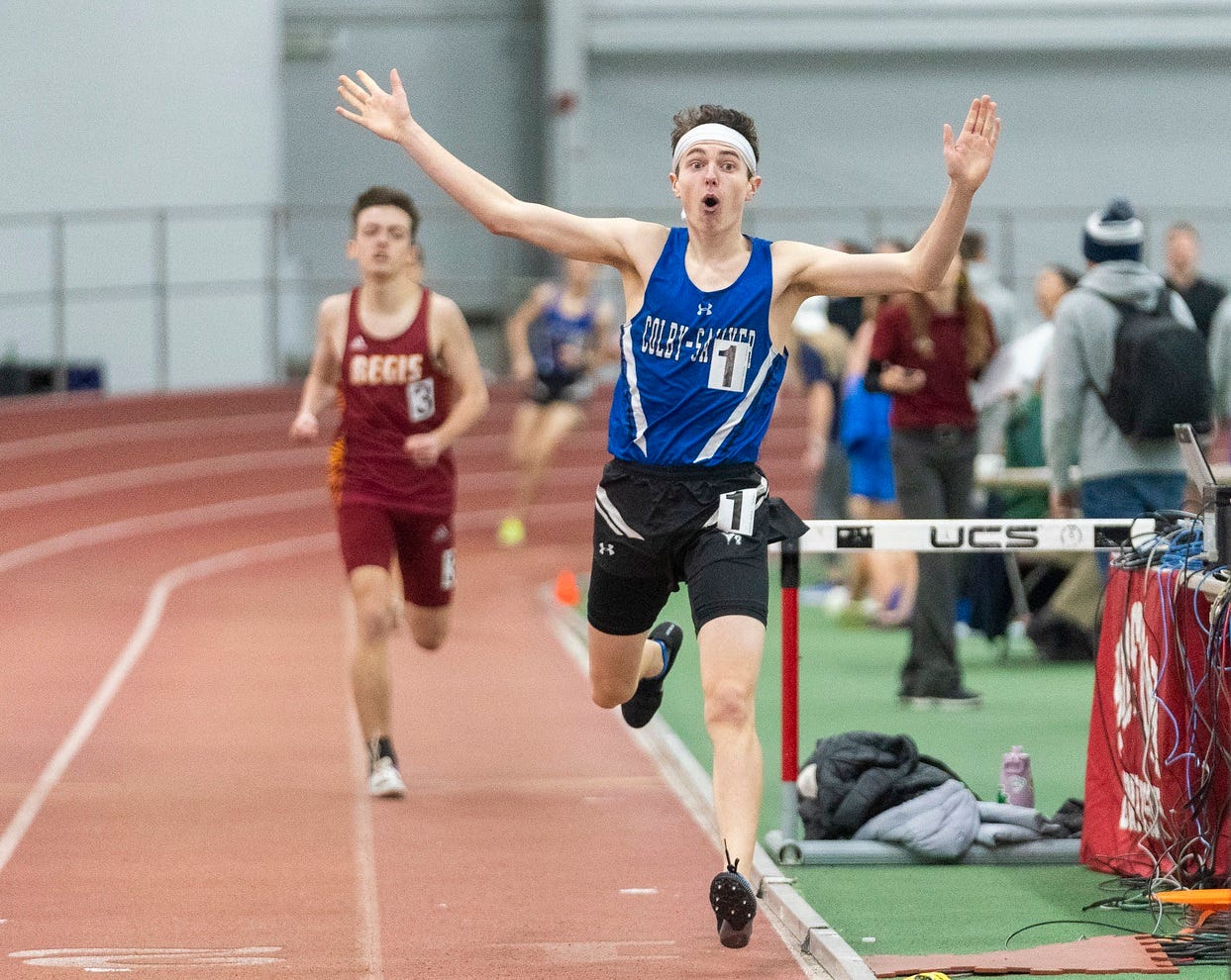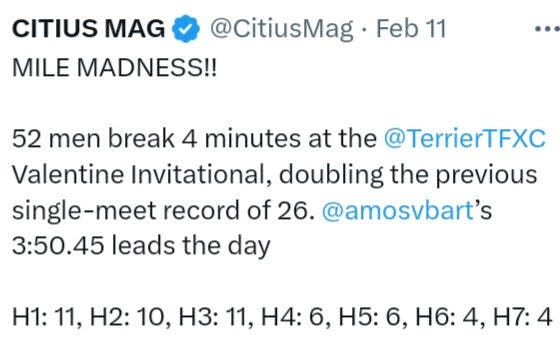Weekend results: Championships. Invitationals! GAMES!
Aidan Cox vs. Alicia Monson over 3K: Who ya got?!?
Indoor track would have been unusually busy over the weekend even if the entire world consisted only of the I-95 corridor between Boston and New York City in the U.S. Northeast.
One of the reasons I don’t feel bad about strongly biasing my coverage toward younger runners, particularly those somewhat northwest of Boston, is that a lot of longtime readers of this blog—older types who were reading it in its Blogspot days and before—are old familiars from New England. This has become complicated by an unforeseen transition to Substack and a more diverse audience, but I think some people like this stuff anyway, and not just because it’s a respite from the ranting.
Another reason is that even were this my full-time job, one person would have a hard time keeping up with just the major happenings of either professional track and road running or collegiate track and field. So, I have to pick specific battles anyway, and I defer to outlets dedicated to running reporting when it comes to major events like the Millrose Games and the Boston University David Hemery Valentine Classic, both of which were held over the weekend.
Starting with the GNAC Championships yesterday, my nephew Hayden outdid himself. After winning the mile in 4:39.82, he won the 800 meters in 2:02.45, a personal best by 4.14 seconds. He then came back to place sixth in the 3,000 meters, then led off the winning distance medley relay team with a 1,200-meter leg.
One of his coaches took this picture of the finish of the 800 meters. I may even have this one developed into a print, which would be a first.
The team placed third despite most individuals overperforming; the two teams that beat them just rose even further above expectations and played the same game of loading up events with as many willing bodies as they could harvest.
Complete meet results are here. I’m not sure precisely what Hayden’s plans are for the slim remains of the indoor season, but when he finally wakes up, I’ll ask him.
At the New Hampshire Indoor High School Championships, also yesterday, Aidan Cox turned in the best distance double in indoor state history in the D-II event. First, he soloed an 8:28.61 3,000 meters, breaking the D-II record (i.e., the meet record) by about 11 seconds despite appearing to back off toward the end to avoid lapping teammate Tyler Tkaczyk, who placed second in 9:04.96.
Cox then ran the 1,500 meters in 3:58.06 to demolish the meet record and just miss the overall indoor state record (which belongs to Jacob Winslow and which I misidentified in my preview post, since corrected). Cox’s 1,000-meter split of 2:36 and change would have earned him third place in the 1,000=meter race that had taken place about an hour earlier.
Cox’s teammate Gavin Demas won the 600 meters by over three seconds in 1:22.74. That’s an impressive time, but the meet record is 1:20.59, set by Russell Brown of Hanover in 2003. Brown went on to run 1:19.41 at the New England Championships at the Reggie Lewis Track Athletic Center, possibly the best race ever run by a New Hampshire schoolboy. (Brown, who went on to run a 3:51.45 mile and won the Boston Indoor Grand Prix over Nick Willis and Alan Webb in 2011, is probably the most talented and accomplished male runner the state has ever produced. Eric Jenkins is up there; Cox may be in the conversation one day.)
The 2023 Division I results are here, and the Division II results are here. I’ll continue to track the progress of the N.H. kids who are moving on to higher-level indoor meets this winter.
The Valentine Classic at B.U. (results) might be thought of as a gathering of bodies not quite fast enough for the Millrose Games, or who weren’t interested in them for whatever reason.
The tweet below summarizes Chris Chavez’s approach and overall understanding of the sport.
Chavez is great at cheerleading and superlatives and listicle-tweets; he needs to be, because he’s left flailing otherwise.
As much of an abandonment of a gold-like standard is it may seem, it’s time to retire the four-minute mile as a mark of genuine middle-distance excellence. Were is not already one, sports fans would be perplexed at why anyone would remark on over fifty athletes accomplishing something at the same competition, given that by definition this means the achievement can’t be that remarkable at this stage in history.
I’m sure Chavez knows that a 3:57.0 today was probably 4:00-4:01 for most milers before the shoes everyone is now wearing arrived two or three years ago; he’s not going to point this out, because he’d then have less to scream about and screaming is all he does. This round of yodeling did lead me to a discovery, though, which is that no women at this meet broke 4:30, a time arguably equivalent to 4:00 for men (World Athletics says 4:36.23, but until that body limits women’s events to women, there’s only so much faith I place in its other standards).
The highlight of the Millrose Games (complete results) was probably 4:06.5 high-school miler Yared Nuguse breaking the indoor American mile record with a 3:47.38, crushing Bernard Lagat’s 18-year-old standard by over 2.5 seconds. To Letsrun’s Jon Gault, this confirmed Nuguse’s status as a superstar. I’d say it makes him an Olympic and World Championship gold-medal contender across multiple events, but the guy ran 7:28.24 for 3,000 meters barely two weeks ago. One of the fun things about track is that certain things automatically qualify you as a superstar even if you choke in every subsequent race, and a 7:28 is one of them, indoors or out.
As fast as 3:47.38 is under any conditions, it only makes me wonder what peak Eammon Coghlan might have run against Nuguse. This is a man who ran 3:49.78 indoors at The Meadowlands in New Jersey in 1983.
The 60 meters featured a whereabouts-failures specialist beating a man who’d been disqualified from the race but was “running under protest,” an option that seems to defeat the entire purpose of an event disqualification. In its Millrose coverage, Runner’s World didn’t even mention that Christian Coleman had been suspended from the sport in October 2020 for two years, instead claiming Coleman had had “a tumultuous few years” and linking to its own article about his suspension.
A few weeks ago, I suggested that Katelyn Tuohy would probably run close to 8:35 for 3,000 meters by the spring of next year. She ran 8:35.20 at Millrose to demolish the NCAA record, but finished over ten seconds behind Alicia Monson, who set an American record in 8:25.05. Both broken records belonged to Karissa Schweizer of the Bowerman Track Club, which suffered further delectable indignity in the event after Tuohy finished two spots ahead of a fading Elise Cranny. Monson is no more trustworthy than anyone else out there, including Brigham Young University grad and recent adidas signee Whittni Orton Morgan (8:30.13 for second to Monson). Actually, Morgan is a devout Mormon, so I’m sure she wouldn’t cut any corners.
I understand that shoe technology has changed the game—I think I just referenced that a few paragraphs above—but it used to take athletes like Shalane Flanagan and Shannon Rowbury years of post-collegiate training to even get into the mid-8:30s. Monson basically looks like she’s lumbering out there and is almost as fast as Aidan Cox. From the nearby camps in the mountains to the triumphant decay of Portland, the stink of suspicion tends to overwhelm the sweet rewriting of performance lists.



